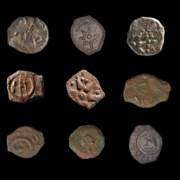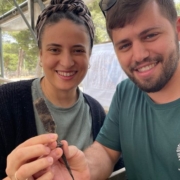Find & Finder of the Month: A Three-Weeks Coin Found by Matanya Hacohen
 Like the rest of the world, we are still struggling with realities imposed on us by COVID-19, but we have been able to resume semi-normal activities at the sifting site, and together with them we are happy to resume our Find of the Month posts!
Like the rest of the world, we are still struggling with realities imposed on us by COVID-19, but we have been able to resume semi-normal activities at the sifting site, and together with them we are happy to resume our Find of the Month posts!
Our finder of the month is Matanya Hacohen, a student at Ariel University, who’s been volunteering at our site as part of an academic outreach program.
Matanya’s find is a small thin silver coin. The coin will need to be professionally cleaned before all its details are revealed, but we can already spot the telltale Crusader motifs – a cross on one side and a stylized depiction of the Tower of David on the other.
Finding this coin in these days was very symbolic. In the Jewish calendar the three weeks between the 17th of Tamuz and the 9th of Av are called Bein ha-Metzarim (“Between the Straits”), which is a period of mourning commemorating the time between the breach of the walls of Jerusalem and the destruction of the Temple. This find connects us to a different breach of the walls of Jerusalem, in a different time and by a different army.
The Crusaders ruled Jerusalem for less than a century but left an indelible impression on the landscape and in the collective memories of Christians, Jews and Muslims alike.
After a pitched battle, the forces of the Crusaders finally breached the walls of Jerusalem on July 15th 1099. This year, this date coincided exactly with the 23rd of Tamuz, the traditional Jewish historical date of this event (which was yesterday). The Crusaders massacred the Muslim and Jewish inhabitants of the city and proceeded to cleanse its holy sites and claim them for themselves. The Dome of the Rock and the el-Aqsa Mosque, which the Crusaders identified as the Temple and palace of Solomon, became respectively, a church and the palace of the King of Jerusalem.
Later on, the palace moved the city’s citadel (the so-called “Tower of David”), while the former palace became the headquarters of the Knights Templar.
While the Church of the Holy Sepulchre remained at the foremost of the Crusader holy sites in the city, the Temple Mount retained its importance and was an integral part of several Latin ceremonies, such as the ritual procession conducted every year from the Church of the Holy Sepulchre, to the Templum Domini (as the Dome of the Rock came to be called) and to the point of the breach, at the city’s north wall. Another procession occurred the next day as the Crusaders commemorated the fallen warriors of the battle of 1099, buried near the Golden Gate. Perchance, one of the participants in these processions is to be thanked for our coin.
This silver coin joins our growing collection of Crusader coins, already replete with rare forms, and containing more than a hundred silver Crusader coins—the biggest and most varied collection of coins from this period found in Jerusalem.
Discover more from The Temple Mount Sifting Project
Subscribe to get the latest posts sent to your email.











Leave a Reply
Want to join the discussion?Feel free to contribute!